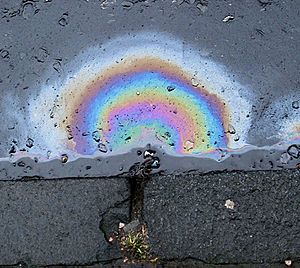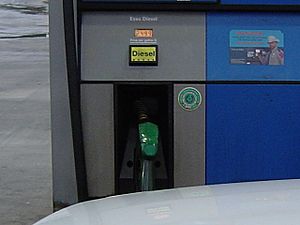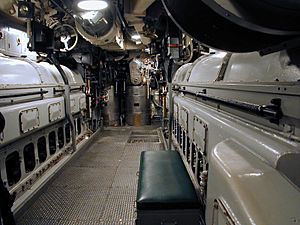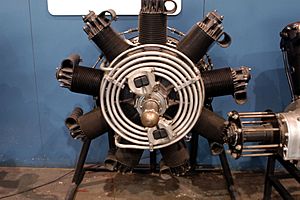Diesel fuel facts for kids
Diesel oil or diesel fuel is a special type of fuel used to power many vehicles. It's also an important source of energy. Most diesel fuel is made from petroleum, also known as crude oil. However, it can also come from other sources like plants or animal fats.
This fuel is named after Rudolf Diesel. He was a German inventor who created the diesel engine in 1892.
Contents
Origins
Diesel fuel came from the experiments of Rudolf Diesel. He invented his special engine, called a compression-ignition engine, in 1892. At first, Diesel designed his engine to use coal dust as fuel. He also tried other fuels, like peanut oil. He even used peanut oil to power engines shown at big events like the 1900 Paris Exposition.
Types
Diesel fuel can be made from different things. The most common source is petroleum. Other sources include plants (called biomass), animal fat, biogas, natural gas, and even coal.
Petroleum diesel
Petroleum diesel is the most common type of diesel fuel. People also call it petrodiesel or fossil diesel. It's made from crude oil using a process called fractional distillation. This process heats crude oil between 200 °C (392 °F) and 350 °C (662 °F). This creates a mix of carbon chains, which are the building blocks of the fuel.
Synthetic diesel
Synthetic diesel can be made from almost any material that contains carbon. This includes biomass, biogas, natural gas, and coal. First, the raw material is turned into a gas called synthesis gas. After cleaning, this gas is changed into synthetic diesel using a method called the Fischer–Tropsch process.
This process is often called biomass-to-liquid (BTL), gas-to-liquid (GTL), or coal-to-liquid (CTL). The name depends on what raw material is used. Synthetic diesel is usually very clean. It has almost no sulfur and very few harmful chemicals. This helps reduce pollution from engines.
Biodiesel
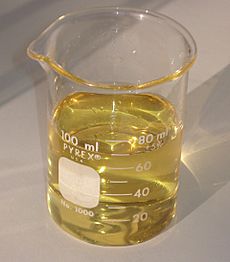
Biodiesel is made from vegetable oil or animal fats. It goes through a chemical process with methanol. Many types of oils can be used. In Europe, rapeseed oil is common. In the US, soybean oil is often used.
Biodiesel can be used by itself in some engines (called B100). But it's more often mixed with regular diesel. For example, B20 means it's 20% biodiesel and 80% petroleum diesel.
Using pure biodiesel can have some challenges. It has slightly less energy than petroleum diesel, so engines might have a little less power (about 5–7% less). Also, it can sometimes cause issues like corrosion in fuel parts or blockages in the fuel system.
Hydrogenated oils and fats
This type of diesel fuel is made by treating vegetable oils and animal fats with hydrogen. The fuel created is very similar to synthetic diesel. It avoids many of the problems that biodiesel can have.
DME
Dimethyl ether, or DME, is a synthetic gas that can be used as diesel fuel. It burns very cleanly, producing very little soot and fewer harmful gases.
Storage
In the United States, diesel fuel is usually stored in yellow containers. This helps people tell it apart from kerosene (blue containers) and gasoline (red containers). In the UK, diesel is typically kept in black containers. This helps to distinguish it from unleaded petrol (green) and leaded petrol (red).
Uses
Diesel engines work differently from gasoline engines. Gasoline engines use spark plugs to ignite the fuel. Diesel engines do not. Instead, a diesel engine squeezes the air inside its cylinders to very high pressures. This makes the air very hot. Then, the engine sprays diesel fuel directly into this hot air. The heat causes the diesel fuel to burn, which pushes the engine's pistons and creates power.
Diesel engines are known as "lean burn" engines. This means they use more air than needed for the fuel to burn completely. Because of this, diesel engines are often more efficient than gasoline engines. They use less fuel to travel the same distance.
One challenge with diesel fuel in cold places is that it can get thick like a gel when it's very cold. This can make it hard for the fuel to flow. Special "winter diesel" has additives to help it stay liquid in low temperatures.
Another thing to know about diesel engines is a rare problem called "diesel engine runaway." This happens if the engine gets too much fuel or if lubricating oil accidentally gets into the engine and burns. The engine can then speed up out of control. Modern diesel engines have safety features, like a valve in the air intake, to help prevent this by cutting off the engine's air supply.
Trucks
Diesel fuel is used a lot in many types of transportation. Most Trucks and buses today run on diesel. In the past, many used gasoline, but diesel became more popular because it's more efficient for heavy vehicles.
Railroad
Trains almost always use diesel fuel for their engines. Diesel engines replaced older steam-powered trains in the last century.
Aircraft
The first flight of a fixed-wing aircraft using a diesel engine happened on September 18, 1928. It was a Stinson SM1B plane powered by a Packard DR-980 diesel engine. Famous pilot Charles Lindbergh even flew this same aircraft.
Diesel engines were also used in large airships, like the famous LZ 129 Hindenburg. It was powered by four Daimler-Benz DB 602 diesel engines. In Germany, the Junkers Jumo 205 was a widely produced aviation diesel engine.
Military vehicles
Armored fighting vehicles, like tanks, use diesel fuel. This is because diesel is less likely to catch fire than gasoline. Also, diesel engines provide a lot of power (torque) and are less likely to stall.
Cars
Diesel-powered cars often use less fuel than similar gasoline cars. They also produce less greenhouse gas pollution. This is because diesel fuel has more energy per liter, and diesel engines are naturally more efficient. A modern diesel car can use 10–20 percent less fuel than a comparable gasoline car.
Tractors and heavy equipment
Today, most tractors and heavy equipment run on diesel. Only smaller tractors might also offer gasoline engines. Using diesel for these machines became common in the United States after World War II.
In the past, many farm tractors could use different types of fuel, like gasoline, alcohol, kerosene, or light fuel oil. Farmers would use whatever was cheapest. These older engines often needed a small gasoline tank to start when cold. Then, after warming up, they would switch to the cheaper fuel. Modern diesel engines are much more efficient and use only diesel fuel.
Other uses
Diesel fuel is sometimes used in drilling for oil and gas. It can be mixed with water to create a special mud called "oil-base mud drilling fluid." This fluid helps drill through difficult rock formations. However, because of environmental concerns, other types of drilling fluids are now often used instead of diesel-oil mud.
Images for kids
See also
 In Spanish: Diésel para niños
In Spanish: Diésel para niños


